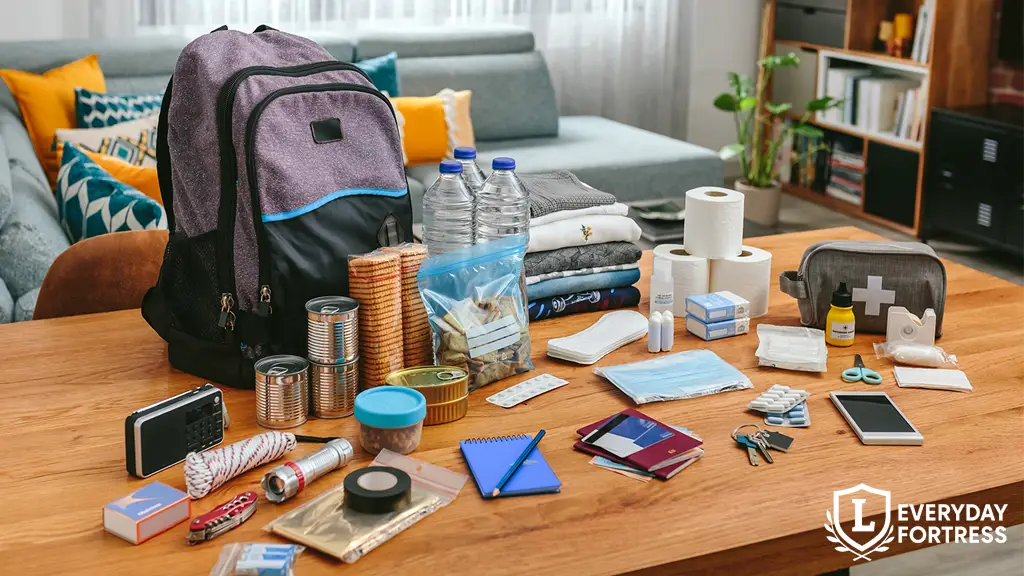If you live in an apartment, you’re not immune to power outages, water shutoffs, or citywide disruptions. That’s why building an urban emergency kit for apartment living is one of the smartest steps you can take. This guide shows you exactly what to pack — and how to store it, even in tight spaces.
But the solution isn’t a basement full of gear. It’s a smart, compact urban emergency kit for apartment dwellers that gives you everything you need for 72 hours — without overwhelming your space.
This post gives you a real-world checklist, storage advice, trusted resources, and the exact reasons this type of kit is essential for city living.
Why You Need an Urban Emergency Kit in an Apartment
Emergencies in cities look different than rural ones. Instead of escaping to open land, you’re dealing with stairwells, shared utilities, and limited storage.
Here are just a few urban-specific scenarios:
- A water main break disables plumbing for your entire block
- An extended blackout leaves elevators and cell towers offline
- A snowstorm shuts down roads and delivery apps for 3+ days
- Civil unrest or flooding makes evacuation risky
In these cases, your apartment becomes your shelter. That means your supplies need to:
- Fit in a small, organized space
- Be mobile if evacuation becomes necessary
- Cover your needs for at least 72 hours without help
Urban Emergency Kit: Apartment Essentials Checklist
This checklist focuses on low-profile, high-impact items that fit inside a closet, under a bed, or in a single backpack.
Water and Hydration
- 1 gallon per person per day (minimum 3 days)
- Collapsible water containers or boxed water
- Water purification tablets or a compact filter (like LifeStraw)
💡 Pro Tip: Store water low and flat — avoid top shelves in case of structural shifts.
See also: FEMA’s water storage guidelines
Food and Nutrition
- Ready-to-eat meals (MREs, shelf-stable pouches, energy bars)
- Manual can opener
- Reusable utensils and paper towels
- Electrolyte packets (small, effective, space-saving)
Avoid items that need cooking, refrigeration, or extra cleanup.
Light and Power
- LED flashlight (plus spare batteries)
- Headlamp (so your hands stay free)
- Charged battery bank (for your phone)
- Hand-crank flashlight with built-in radio
Power Tip: Keep one light source in your bedroom and another near your kit.
Communication and Alerts
- Battery-powered radio or hand-crank NOAA radio
- Whistle (to signal through stairwells or debris)
- Printed emergency contacts and building manager’s number
- Backup charging cable
More tools: American Red Cross emergency kit basics
First Aid and Health
- Standard first-aid kit (add gloves and tweezers)
- 3-day supply of personal medications
- Face masks and hand sanitizer
- Feminine hygiene products (don’t forget these!)
Rotate medication and batteries every 6 months.
Warmth and Shelter
- Mylar emergency blanket (space-saving but heat-retaining)
- Compact sleeping bag or fleece roll
- Duct tape (seal windows, patch bags, quick fixes)
- Lightweight rain poncho
City Advantage: No need for a tent — just make your room more secure and warm.
Personal Protection and Tools
- Multi-tool or utility knife
- Gloves for debris or broken glass
- Fire extinguisher (your building may already require one)
- Small crowbar or doorstop
- Spare keys and $50–$100 in small bills
You’re not trying to survive in the woods — just stay safe and mobile in a complex building.
Documents and Digital Backups
- Copies of your ID, lease, insurance, emergency contact card
- Encrypted USB with digital backups of important records
- Waterproof folder or pouch
Bonus: Keep a scanned version in a password-protected cloud account (like Google Drive or Proton Drive).
Storage Tips: Where to Keep Your Kit in a Small Apartment
Even in tight quarters, you can fit a full emergency kit. Try these real-world spots:
- Under-bed bins with wheels
- Top shelf of hallway or bedroom closet
- Inside a backpack (for a mobile “go bag”)
- Behind sofa or in unused kitchen cabinet
Split your items into two categories:
- Stay Kit: For sheltering in place
- Go Bag: For fast evacuations (ideally in backpack form)
How to Test Your Urban Emergency Kit at Home
Once you’ve packed it, don’t forget to test it.
Try this:
- Turn off your power and water for 2 hours.
- Use only your emergency kit.
- Take notes on what’s missing, uncomfortable, or frustrating.
This one small test will tell you more than hours of online research.
5 Common Mistakes to Avoid in an Apartment Emergency Kit
- Storing everything in hard-to-reach places
– During an emergency, you may not have time to access high shelves or storage lockers. - Packing items that need electricity to work
– Skip plug-in lanterns or electric hot plates unless you have backup power. - Assuming building security equals personal security
– Keep a small personal defense item if allowed (check local laws). - Ignoring sanitation
– Include wipes, gloves, and small trash bags. No plumbing means no cleanup. - Not rotating your items
– Water, meds, and snacks all expire. Set a calendar alert every 6 months.
🧠 You May Wanna Check Out:
Final Thoughts
You don’t need a garage or gear bunker to be prepared. With a smart, focused urban emergency kit for apartment dwellers, you can stay safe, ready, and in control — even if the city around you slows down or shuts off.
Start with what you have. Build what you need. And update it twice a year. You’ll never regret being ready.


